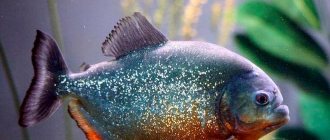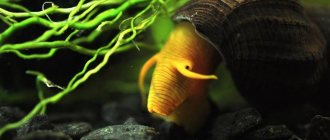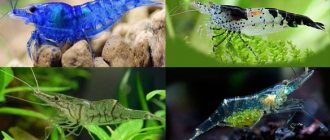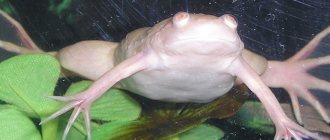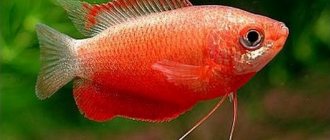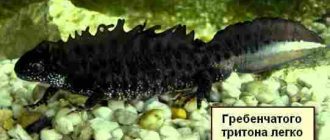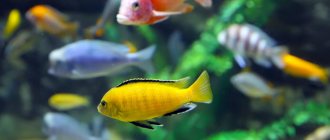Freshwater snails are an important part of the aquarium ecosystem; keeping them at home does not require much effort. The reproduction of most heterosexual and unisexual species of mollusks is unusually fast; in a short time, young individuals fill the aquarium space. Aquarists should know how snails reproduce in order to promptly remove excess young and prevent overpopulation.
Unisexual and heterosexual species of snails
The mollusks living in the aquarium are bisexual and hermaphrodite. In the first, a male and a female participate in reproduction; these are the following species:
- Ampoules;
- Tiger snails;
- Neretina;
- Maryse;
- Tylomelania;
- Predatory Helena;
- Pagodas.
Hermaphrodites are snails that can change sex depending on the characteristics of the population and reproduce without the participation of individuals of the opposite sex. These are the following types:
- Tropical pond snails;
- Fizy;
- Coils;
- Tuberous melonoides.
Achatina achatina
Tiger snails, like most representatives of Achatina, after cross-fertilization, lay clutches (both partners) consisting of 200 - 300 eggs.
The incubation period should take place in a container separate from the general terrarium, in moist soil, at +25C + 27C.
After 15 - 25 days, you can expect the appearance of offspring.
Creating conditions for snail breeding
Reproduction at home among mollusks occurs almost continuously. Without control of the situation, in a short period of time, young individuals literally flood the aquarium space.
How to create comfortable conditions for snail breeding in an aquarium:
- for 4 individuals, take a tank with a volume of 30 liters or more;
- control the water temperature within 25-28°C;
- hardness and acidity do not matter, leave these water parameters the same as usual;
- give food in sufficient quantities once a day or two;
- feed with regular food with the addition of boiled vegetables and bread;
- enrich the diet with calcium;
- change the water weekly without adding water to the edge of the aquarium;
- remove uneaten food from snails.
Eggs are laid on the leaves of underwater plants, tank walls, and decorative elements.
Table of basic parameters of maintenance, care and nutrition:
| What should be the volume of the aquarium? | for most types from 10 liters for some types from 90 liters |
| What should the temperature be? | from +18-30° C depends on the type |
| What pH should it be | from 6.5-8 pH |
| What should be the stiffness? | from 8-18° dH |
| What should the substrate be? | coarse or fine sand, fine grains of substrate (soil) 1-2 mm in size |
| What kind of lighting should there be? | moderate |
| What should be the movement of water | moderate |
| Maximum size | from 1.5-9 cm, depends on the type |
| What does it eat? | aquarium algae: healthy or rotting; fish food; raw or boiled vegetables |
| Type of aquarium snail | depends on the type: peaceful; predators |
| Who is compatible with in an aquarium? | compatible with all peaceful aquarium inhabitants |
| Lifespan | from 1-5 years depending on the type and conditions of detention |
How do ampullaria reproduce?
Popular Amazonian snails with a yellow or brown-yellow shell reach a diameter of 10 cm. Ampularia is a heterosexual species.
It is impossible to determine the gender; the female does not differ from the male in appearance. Therefore, aquarists buy 4-6 individuals for breeding. You can understand which gender is which by seeing how ampullaria reproduce in an aquarium: the male is always on top during the mating process.
Sexual maturity occurs at 1.5 years. How do yellow snails reproduce in an aquarium:
- After fertilization, eggs are formed in the female's body.
- She deposits them above the water in the form of a slimy mass that hardens in the air.
- In nature, masonry rests on coastal stones and plants. In ampullaria, reproduction in an aquarium occurs on a glass aquarium wall.
- At first, the eggs are translucent, white, with a soft shell, and are 2 mm in diameter. They gradually darken - shells form inside. Just before the young hatch, the eggs are dark brown and hard.
- The developed snails gnaw through the shell of the eggs and come out.
It is necessary to monitor how the snails lay eggs in the aquarium: the clutch should not be allowed to get into the water or get wet, otherwise the embryos will die. How to care for ampularia eggs: drying out of the masonry is unacceptable; if it is laid near a lighting fixture, it will have to be carefully cut off and moved to another place inaccessible to fish and predatory snails. To make it easier to care for caviar, you can place it on a piece of foam plastic placed on the surface of the water.
How quickly snail eggs mature in an aquarium depends on the temperature of the surrounding water. At a temperature of 24-26°C, the ripening period is 2 weeks. At 20°C, young animals appear after 3 weeks.
Caring for young animals is simple: feed – duckweed, finely chopped lettuce leaves, dry planktonic crustaceans. When bred in a community aquarium, young specimens can be eaten by fish, so it is better to move them to a separate tank.
Laying eggs
Sometimes the formation of eggs followed by laying occurs in mollusks a short period of time after fertilization. But in some cases this process may drag on indefinitely. And sometimes it doesn’t happen at all. This may be a consequence of unfavorable environmental conditions (too dry or waterlogged soil, cold), lack of sufficient food, etc.
In some species of mollusks, the desire to become parents appears in the autumn, before hibernation. In this case, embryos begin to form only with the arrival of spring, when awakening occurs after winter diapause. Some species of land mollusks will require repeated fertilization in the spring, since over the winter the partner’s sperm lose their original properties (fertility).
If the snail has had sexual contact with several partners, its fertilization occurs through the most viable sperm. But at the same time (according to experts), pregnancy is possible from several partners at once.
Most snails (aquatic and land) first lay eggs, where the embryo develops. Moreover, the number of eggs in the clutch depends on the age of the mollusk. The older he is, the more numerous his offspring are.
How do Achatina reproduce?
African Achatina are large land mollusks, with high-quality care and maintenance, reaching up to 30 cm in diameter, weighing up to 500 g. Sexual maturity occurs at one year of age. Egg laying occurs every 2 months.
Achatina is a unisexual species, although its representatives are not prone to self-fertilization. More often, individuals fertilize each other. Moreover, they do not have female and male reproductive organs; instead, calcareous formations come out of the front part of the body. The function of the female, that is, the carrier of eggs, is taken over by a larger individual whose body is stronger. Sperm in the Achatina body is stored in a viable state for up to 2 years.
How do snails reproduce in an aquarium?
- Pregnancy lasts 2 weeks.
- Then the pregnant female lays about 200 eggs for further 2-3 weeks of gestation.
- Eggs have a hard shell. As the embryos develop, it becomes thinner and releases minerals to the developing shell.
- When the shell becomes very thin, the snail breaks it and is released.
Feeding of young animals is the same as for adult mollusks. But the food needs to be crushed.
Mating Achatina
A pair of snails is needed to reproduce. One snail is also capable of laying eggs, but it will be a false clutch.
Snail selection
To get healthy and viable offspring, it is important to choose the right snails. Only strong, large and healthy snails are suitable for breeding. The shell of future parents must be strong.
When choosing sick individuals that have a fragile shell with detachments, the probability of snail death is very high. Laying eggs takes a lot of strength and energy from Achatina. During this period, she needs feeding and a special diet rich in calcium.
For breeding, experienced owners choose snails aged 1 year or older. By this age, Achatina not only become sexually mature, but also grow to large sizes. Since the snail spends a lot of energy during the reproduction process, at this time its development and growth stops.
When choosing a partner, it is necessary to take into account that it must be of the same species and the same variety.
In order to choose the right snails for breeding, you need to focus on 2 indicators:
- Snail size. If you choose snails of the same size, both mollusks will lay eggs. If one Achatina is larger, then it will lay eggs.
- Age of snails. For successful reproduction of Achatina, it is better to take one young snail and another older one. The thing is that young snails produce mainly sperm, while adult snails produce mainly eggs. Therefore, snails of different ages are always paired.
If the snails are related, you cannot mate them with each other!
Conditions for reproduction
If a pair of snails lives in the same aquarium, then changing the soil or general cleaning of the aquarium can serve as an incentive for reproduction.
But owners who breed snails try to prevent unplanned offspring. Therefore, most of the time they keep Achatina separately.
To get offspring, the snails must be placed in a separate container and covered with a lid so that they do not crawl away. You must make holes in the lid.
Conditions for reproduction:
- The container should be spacious enough for a pair of snails.
- Periodically spray the soil and walls of the container with a spray bottle.
- Maintain an optimal temperature of 25-27 degrees and humidity around 70%.
- Increase the amount of calcium in the snails' diet.
- Carry out cleaning with changing the soil.
The conditions for reproduction are practically no different from the usual conditions for keeping snails. It is during this period that it is necessary to constantly monitor conditions and adhere to care rules. Do not allow the soil to dry out, temperature changes or drafts. Pairing
In a separate container, the snails will crawl and rub against each other, exchanging seed. Mating games last from a couple of hours to a day. On average, mating and fertilization takes 2 hours.
1 week after fertilization, small testicles will be visible in the breathing hole. The snail hatches eggs for 1-2 weeks. During this period, it is especially important to feed the snail properly.
If the snail does not like the soil, it can delay the gestation process. Accordingly, after laying, the snails may hatch earlier than usual.
A snail can store sperm in its body for 2 years. She can fertilize herself without a partner and make 2-4 clutches per year.
Owners who purchased a snail already at puberty are always surprised when Achatina begins laying eggs. There is very little time to make a decision, otherwise small snails will begin to hatch from the eggs. We discussed in detail what to do in this case in the article What to do if Achatina laid eggs.
Reproduction of other types of snails
Let's look at how other popular types of mollusks mate and how to breed them in an aquarium:
- Melanias are viviparous snails. They can reproduce by parthenogenesis, that is, without fertilization of the female by the male. Young individuals are born full-fledged. More than 10 cubs are born in one birth.
- Pagodas are livebearers and reproduce once a year. Childbirth occurs a month after mating.
- Maryses mate for almost 24 hours. Snail eggs in the aquarium appear every 4-5 days and mature within a week. In males, the fleshy leg is light with brown speckles, in females it is dark brown with black spots.
- The coils are multiplying rapidly. What does caviar look like: it is translucent, similar to bubble wrap, but hard. The young appear after 3-4 weeks.
- Physidae are characterized by rapid reproduction. About 20 laid eggs mature in a month.
- Neretina breed in warm salted water. Since there is no sexual dimorphism, 8-10 individuals are selected in preparation for reproduction.
- Predatory helenas lay 1-2 eggs. After spawning, they bury themselves in the ground and come to the surface only six months later.
- Tylomelania lay 2 eggs. Preparation for spawning includes installing a separate tank.
In most species, eggs take up to a month to develop. If after this period the young animals have not hatched, the clutch will have to be destroyed: it is dead.
Caracolus
Sexual maturity in tree snails occurs at 11–13 months. Both partners are capable of producing offspring.
Laying sometimes occurs several months after fertilization. The number of eggs in it is 10 - 15 pieces.
The incubation period lasts 10 – 14 days at +24C -+26C. When the temperature rises by 2–3 degrees, the birth of babies can be expected within 5–6 days.
What to do with extra snails
To remove excess shellfish from an aquarium, the following methods are used:
- Use chemicals from a pet store and add them to the aquarium water according to the instructions.
- Electric current is applied. This method of regulating the number of mollusks is only for experienced aquarists.
- Adults and eggs are caught by hand.
- They breed mollusks that do not reproduce in fresh water.
- They breed a predatory helena, which produces small offspring and devours other mollusks.
Reproduction of snails, which perform an important role as cleaners in a community aquarium, is not difficult. The aquarist only needs to control the number of individuals and prevent overpopulation.
Diseases
Most often, diseases arise due to improper maintenance. If you do not feed the snail with calcium, the shell will begin to deteriorate. And you can also add eggshells, shells or chalk (all crushed) to the water. The cuttlefish skeleton (there are a lot of proteins there) can be lowered into the aquarium, the snails will gradually scrape it off.
If there are indentations on the sink, these are most likely mites. You should carefully remove the pet from the water, blot the shell with a soft cloth, then wipe it with a cotton swab soaked in formaldehyde. Protect the animal from getting this liquid on its body.
A white coating on the shell indicates the presence of other parasites. Then you need to place the snail in a salt solution (10 g per 1 liter of water), hold for 15 minutes.
Due to lack of oxygen, the animal may fall into a coma and because of this, the snail may not crawl out of its shell. The clam should be transplanted into a jar of clean water.
Sometimes diseases include green plaque on the sink. But this is not so, you just need to clean the shell with a soft toothbrush (without soap or other products).
Conclusion
Some species help keep the aquarium clean by reaching where human hands and tweezers cannot reach. These mollusks are part of different environments and provide food for many organisms, so they should be considered a necessary and important part of any aquatic ecosystem.

